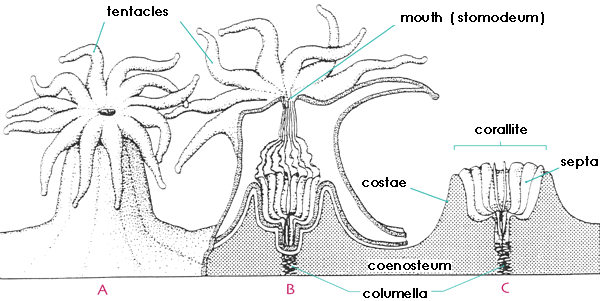


|

|
BIOTIC LOCALISATION
3.gif)
(from 'Les coraux' - B.Robin, C.Petron, C.Rives - Les Editions du Pacifique)
Outer slope
Seaward part of the reef, always below water, slope of variable steepness. Two zones are separated (each divided into 2 subzones) essentially by their depth (considered in terms of variations of light intensity and agitation) and by the initial topography.
- Volcanic pavement zone (25-60 m)
Lower part of the outer slope. Its morphology reflects that of the underlying volcanic bedrock. It is colonized by algal/coral calcareous deposits of variable thickness.
- Lower horizon
depth 35 m-60 m (or more)
- Upper horizon
depth 25-35 m
- Spurs-and-grooves zone (0-25 m)
Series of bioconstructed ridges (the "spurs") and erosional furrows (the "grooves") generally perpendicular to the reef front and present to a maximum depth of 25 m.
- Lower horizon
depth 10-25 m
- Upper horizon
depth 0-10 m
Reef flat
The reef flat corresponds to subhorizontal upper part of the reef construction. It may be emersed during low spring tides. It includes a variety of communities which are distributed in one of the two majors divisions:
- outer reef flat
It is the part of the reef flat subjected to strong swell and wave action, particularly towards the reef front (upper part of the spurs) which represents the boundary with the outer slope. Its width varies from a few metres to more than 300 m. It is limited landwards by the boulder tract (the latter is an accumulation of dead coral blocks torn up from the reef front during cyclonic storms). When the boulder tract is absent, the transition to the next zone (inner reef flat) is progressive and is observed by a change in the coral communities.
- inner reef flat
The inner reef flat is situated between the outer reef flat and the back reef. Prevailing hydrodynamic conditions vary from semi-exposed to calm.
Back reef
The back reef is divided in two zones :
- Zone dominated by coral construction (bioconstructed zone)
This zone remains dominated by corals colonies and coral patches which can be scattered on the bottom or fuse together (particularly towards the neighbouring inner reef flat). It can merely be a shallow depression (depth of approximately 1 m) or when the depth increases a small lagoon with numerous coral patches.
- Sedimentary zone
Shorewards the back reef slope is a sedimentary area which may be colonized by seagrass beds.
STRUCTURES

(from 'Coral Reef Handbook' - P.Mather, I.Bennet - Surrey Beatty &sons Pty Lted)
A - Polyp
B - Cross section of a polyp and of the skeleton
C - Soft parts have been removed to show the skeleton only (corallite)
Colony
Collection of individuals (polyps) and their skeletal production (corallites). Some species however are solitary (do not form colonies).
Corallite
Cup-shaped skeletal unit, secreted by the polyp and in which it can withdraw and shelter. Each corallite is composed of two parts: the basal plate and the wall (or theca).
Basal plate
Horizontal skeletal element (calcareous lamella) which forms the base of the corallite on which the wall (or theca) is established.
Wall (Theca)
Calcareous element which constitutes the boundary of the corallite and separates it from the outside. Its development may vary significantly. It may be symetrical or not, in which case it forms a hood.
Septa (Sclerosepta)
- Definition
Vertical lamellae arranged in a radial symmetry based on 6 (hexacorals) and which divide the corallite cavity in chambers (in multiple of 6).
- Distribution
- Ornamentation
The free margin of the septa (axial margin) generally bears a number of teeh of variable size. occasionally, in the deeper part of the corallite, one of the teeth is particularly well developed and is named a paliform tooth or paliform lobe. The distal part of the septa bears septo-thecal teeth of variable development above the coenosteum.
Columella
Axial element arising from the basal plate in the center of the corallite, with variable shape (styliform, lamellar, papillose) and ornamentation.
Coenosteum (Peritheca)
Collection of skeletal elements located between the corallites. It is divided into 2 parts :
- Exotheca
All of the skeletal tissue in the space between the corallites. Its surface bears spines of variable development. Some spines may have a particular orientation (alignment) and fuse to form a flattened ridge.
- Costa
Extension outside of the corallite of the septa (peripheral margin). They may be continuous or discontinuous.
Groove
Furrow of variable depth separating two or several corallites.
[ Description tree | Corals of the Mascarenes | Welcome | Top ]
© IREMIA - IKBS team - 11/2000